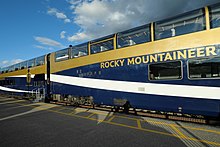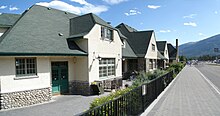Jasper (Alberta)
| Jasper | ||
|---|---|---|
 View of Jasper |
||
| Location in Alberta | ||
|
|
||
| State : |
|
|
| Province : | Alberta | |
| Region: | Jasper Improvement Area | |
| Coordinates : | 52 ° 52 ′ N , 118 ° 5 ′ W | |
| Height : | 1062 m | |
| Area : | 5.41 km² | |
| Residents : | 3560 (as of 2011) | |
| Population density : | 658 inhabitants / km² | |
| Time zone : | Mountain Time ( UTC − 7 ) | |
| Postal code : | T0E | |
| Foundation : | 1813 | |
| Website : | www.jasper-alberta.com | |
Jasper is a settlement within Jasper National Park in the Canadian province of Alberta at the confluence of the Miette River and the Athabasca River . Throughout its history, this town has served as the trading post of the Hudson's Bay Company under the name Jasper's House .
location

Jasper is located in Jasper National Park near the border between the provinces of British Columbia and Alberta at an altitude of 1062 m . The community is accessible from the west and east via the Yellowhead Highway (Alberta Highway 16) and from the south via the Icefields Parkway (Alberta Highway 93).
The village of Jasper has an area of around 5 km², while the Specialized municipality of Jasper has an area of 925.5 km².
There is also a railway line through Jasper. The transcontinental long-distance train The Canadian connects Jasper with Vancouver and Edmonton - Saskatoon - Winnipeg - Toronto as well as the rest of the North American railway network.
In addition, Jasper train station is also the starting point of the long-distance train towards Prince George - Prince Rupert . This train no longer carries the train name The Skeena since 2009, as almost all train names were deleted by VIA Rail Canada , but the train continues to operate.
Both trains are operated by VIA Rail Canada and are particularly popular with tourists.
Jasper is 287 km from Banff , 362 km from Edmonton , 414 km from Calgary and 863 km from Vancouver .
population
According to the 2011 census, Jasper has a population of 3,560 and the Specialized municipality has a population of 4,051.
The influx of people to Jasper is heavily regulated by the Canadian park administration. Only people who are employed there are allowed to reside in Jasper. The acquisition of real estate is similarly strictly regulated and prohibited for foreigners.
climate
| Mean values (long-term) |
Temperature (max / min) (daily average) |
Rain / snow amount (per month) |
|
|
|
history
The first historically recorded visit was made by cartographer David Thompson to the Athabasca Valley in 1810. The North West Company set up a replenishment warehouse on Brule Lake in 1813 , a branch that over time was named "Jasper House", named after the North West Company employee , Jasper Hawes .
The biography of Jasper Hawes is apparently only partially known. He was from Missouri and appears to be married to a Native American. The two had a daughter named Genevieve and other children. A contract with the Hudson's Bay Company from 1817 is apparently in their archives.
The post was headed by François Decoigne from 1813 to 1817. In 1829 Michael Klyne moved the trading post to the confluence of the Athabasca and Snake Indian rivers. He ran the station under the name Michael Cline from 1825 to 1835, but from 1798 onwards he worked for the Hudson's Bay Company. Mount Cline is named after him, as is the Cline River.
He signed his contract on February 22, 1798 before the notary Chaboillez in Montreal, initially for Nepigon on Lake Superior. Michael Klyne was of Dutch descent and born in 1781 or 1783. Around 1807 he married the Metis wife Suzanne Lafrance, who was born in the Northwest Territories in 1790. 1822-23 he was employed as an interpreter in the Lesser Slave Lake District. When Governor Simpson reached Jasper House on October 10, 1824, he was employed there, as was on his return trip on April 27, 1825. Klyne hired himself as a laborer, canoe builder, housekeeper, interpreter, fisherman and postmaster. From the Council of the Northern Department he was commissioned from 1829-34 as head of the Jasper House, then moved with his large family to the Red River. Jane, one of his daughters, married the chief factor Archibald McDonald. (Minutes of Council Northern Department of Rupert's Land, 1821-31. The Hudson Bay Record Society, 1940, pp. 443-444).
With the decline in the fur trade, Jasper House was abandoned in 1884. The Canadian government established the "Jasper Forest Park" in this region in 1907 on an area of around 13,000 km². By 1911, the Grand Trunk Pacific Railway was extended to Fitzhugh Station , now Jasper Station . In 1928 a connection road from Jasper to Edmonton was opened. In 1930 the "Jasper Forest Park" was officially renamed "Jasper National Park".
administration
The Jasper community is special in that it is completely within a national park . The administration of the community is shared equally by the six-member local council with the elected mayor and the Canadian national park administration, Parks Canada .
Web links
- Jasper ( English, French ) In: The Canadian Encyclopedia .
- Jasper (English)
Individual evidence
- ↑ Statistics Canada (2011 Census). Jasper (Population Center) Profile , accessed July 11, 2012
- ↑ Statistics Canada (2011 Census). Jasper (Specialized municipality) Profile , accessed July 11, 2012

